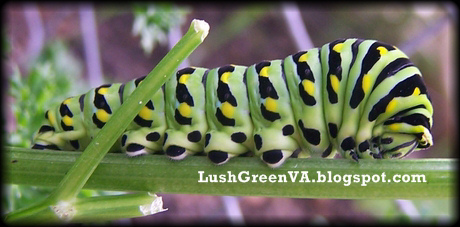 |
| Side view of the parsley worm (Black Swallowtail Caterpillar) |
With the first frost on the horizon, I went out for my final parsley harvest of the season - and much to my visual delight, I found two of these beautiful caterpillars resting on the stems of the plants.
Turns out they are actually the Black Swallowtail Butterfly in caterpillar form, appropriately called the Parsley Worm.
The caterpillars I photographed here are in their last stages of growth, shortly before starting their 9 to 11 day chrysalis stage.
Frequently found resting & munching on parsley, they also enjoy the leaves of carrots, dill, celery & parsnips. Signs of their presence include chunks of leaves missing along the edges.
While just a few of these caterpillars pose no major threat to your herbs, many of them can simultaneously eat your plants down to their nubs. Take action when 25% of your plant is damaged.
 |
| Range map of the Black Swallowtail & a picture in butterfly stage. |
Eliminating parsley worms can be done by using chemical pesticides or picking them off by hand. However, do not use chemicals if you plan on eating your herbs or vegetables. In these cases, you must remove them physically by hand.
Keep in mind that when threatened, these Parsley Worms reveal a forked snake-like small tongue. Though the tongue itself is not harmful, this gland emits a foul odor so you may want to consider handling these insects using gloves.
 |
| Close up view of the head & neck area. |
If these little critters are doing no major harm, get up and close and enjoy your time with the beautiful Parsley Worm.
|
|